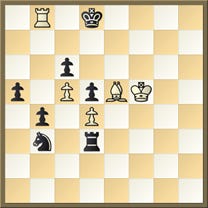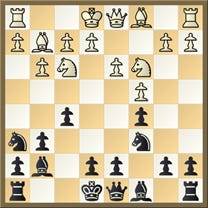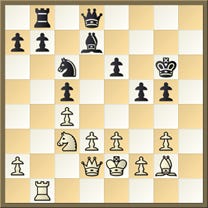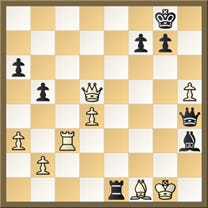Michael John Basman (1946 – 2022)
The ECF was very sad to learn of the passing on 26 October of International Master Michael Basman
Michael was a renowned English chess player, author and organiser who was awarded the international master title in 1980.
As well as competing at the highest levels of English chess over many years, his achievements included popularising the Grob and the invention of the Basman Attack and St George Defence openings, the latter being used by GM Tony Miles to defeat GM Anatoly Karpov. He also founded and organised the UK Chess Challenge in 1996 and was a central figure in bringing chess to several generations of junior players.
In 2020 he was one of ten chess seniors who were the subject of a tribute by FIDE for their contributions to the game. He was described in the tribute as a guru of the English chess scene and a true iconoclast, both descriptions being well merited.
We send our condolences to Michael’s family and to his many friends and colleagues on the passing of a much-respected figure who made such a huge contribution to English chess. He will be greatly missed.
Tribute by Sarah Longson
Mike was the founder of the UK Chess Challenge, and his efforts encouraged me and millions of other kids to enjoy the wonderful benefits of this game. I won the Girls edition in the first year of the event, which inspired me to compete regularly, and I ended up playing all over the world. I’ll always be grateful for this introduction to the game, as I am for the support and advice he gave to Alex and me when we took on the organisation of the competition.
I remember many entertaining discussions with Mike - not least about modernisation. Mike was initially quite sceptical about computers in chess and resisted the trend to produce pairings on Swiss Manager. ‘But what if the laptop breaks?’ At the 2018 Terafinal prize-giving he seemed to be won over: ‘These computers are marvellous – can they present the prizes as well?’ In the last few years Mike even took to streaming.
It certainly wasn’t an aversion to modernisation that delayed Mike’s adoption of computers. Mike was almost by definition a moderniser. Ignoring for a moment his contribution to opening theory, he introduced teaching chess via cassette tapes under the name Audio Chess. This can be seen as a precursor to the video instruction, DVD instruction and online instruction trend that followed and is so prevalent today. He brought many new ideas and innovations to life through the UK Chess Challenge - not to mention some much-needed humour.
Mike’s wicked sense of humour could certainly be seen in his opening choices (1.g4 as White and 1…g5 as Black). Just a few days before his untimely death we were joking about how even the World champion Magnus Carlsen was finally adopting his openings in a recent Chess.com Titled Tuesday event. The two openings that Mike is perhaps best known for are the Grob (1.g4) and the St George (1…a6).
Speaking of the St George – the only time I actually played Mike was at a blitz event held in a pub in London. After 1.e4 and with a twinkle in his eye he essayed 1…a6 and beat me in about two minutes.
The energy, originality and joy that Mike brought to all his endeavours are a source of great inspiration. He believed that young minds should be encouraged to be rational, compassionate and creative, and that through chess and the UK Chess Challenge he could help develop these traits in the next generation. Mike was a fighter at the board and away from it - not afraid to stand up for his beliefs.
Mike leaves behind an incredible chess legacy and I know that many of his former students, friends and acquaintances will be deeply saddened by his passing. Our condolences go out to his family and nearest friends.
Opening Theory
Michael was justifiably renowned for his contribution to opening theory with a range of offbeat openings including
The Basman Attack - 1 e4 e5 2 Nh3.
The Creepy Crawly - 1 a3 and 2 h3 against anything.
The St George Defence 1 e4 a6 2 Any move …b5.
He also authored many books including the classic The Killer Grob – long out of print, but worth seeking out a copy if you play the Grob or expect to face it.
Michael was an active chess player up to 2022 and lived long enough to see Magnus Carlsen adopting 1 g4 and 1 …g5 in some recent online games including Chess.com’s Titled Tuesday which we feature elsewhere in the issue.
As well as a ground-breaking theoretician he was also a fine chess player, with the following games highlighted amongst the many tributes on social media following his passing.
Basman was one of the top English players in the late 60s and 70s. Here is his game from the 1966/1967 Hastings Christmas Congress where he draws against the great Mikhail Botvinnik with some deep positional play against Botvinnik’s English Four Knights Opening. Basman is close to winning the game with his passed queenside pawns, and Botvinnik is lucky to escape with a draw by perpetual check.
(10692) Mikhail Botvinnik - Michael John Basman [A29]
Hastings 1966/67 Hastings ENG (8), 05.01.1967
1.c4 e5 2.Nc3 Nf6 3.Nf3 Nc6 4.g3 Bb4 5.Bg2 0–0 6.0–0 Re8 7.d3 Bxc3 8.bxc3 e4 9.Nd4 exd3 10.exd3 Nxd4 11.cxd4 d5 12.Be3 Be6 13.Rc1 h6 14.h3 c6 15.Qd2 Qd7 16.Kh2 Kh7 17.Rfe1 Ng8 18.g4 Ne7 19.Bf4 Rad8 20.c5 g5 21.Be5 f5 22.gxf5 Bxf5 23.Re3 Ng6 24.Rce1 Re6 25.Bg3 Rde8 26.Bf1 Qg7 27.Rxe6 Bxe6 28.Be5 Qf7 29.Bg3 Qf5 30.Qd1 Rf8 31.Bg2 Rf7 32.Re3 Qf6 33.Qe1 Bd7 34.Qb4 g4 35.hxg4 Bxg4 36.Qb2 h5 37.Kg1 h4 38.Bd6 Qf5 39.Bf1 Bf3 40.Kh2 Bd1 41.f4 Nxf4 42.Qf2 Ng6 43.Qxf5 Rxf5 44.Kg1 Bg4 45.a4 Kh6 46.Re8 Rf7 47.a5 a6 48.Re3 Kg5 49.Re8 Kh5 50.Rg8 h3 51.Re8 Nh4 52.Rh8+ Kg5 53.Rg8+ Kf5 54.Kh2 Nf3+ 55.Kg3 Nd2 56.Bxh3 Bxh3 57.Kxh3 Nb3 58.Kg3
58...Nxa5 59.Kf3 Nb3 60.Ke3 Rh7 61.Rf8+ Ke6 62.Re8+ Kd7 63.Rb8 Rh3+ 64.Kf4 Na5 65.Kf5 b5 66.Rg8 Rf3+ 67.Ke5 Re3+ 68.Kf5 Rf3+ 69.Ke5 Re3+ 70.Kf5 b4 71.Rg7+ Kc8 72.Rc7+ Kd8 73.Ra7 Nb3 74.Be5 a5 75.Rb7 Rxd3 76.Rb8+
½–½
Basman later tied for first place on 8½ out of 11 in the 1973 British, losing out in the play-off against William Hartston.
Here is a fine example of Basman’s playing style where he draws against GM Tony Miles, with both players’ kingsides disappearing.
Anthony Miles - Michael John Basman [A04]
BCF-ch Eastbourne ENG (7), 13.08.1973
1.Nf3 c5 2.g3 f5 3.Bg2 g6 4.c4 Bg7 5.Nc3 Nc6 6.d3 Nh6
7.h4 Nf7 8.h5 e6 9.hxg6 hxg6 10.Rxh8+ Bxh8 11.Be3 Nd4 12.Qd2 Bf6 13.Rb1 d6 14.b4 Kf8 15.bxc5 dxc5 16.Na4 Qc7 17.Kf1 Kg7 18.Ng5 Rb8 19.Nxf7 Kxf7 20.Bg5 Bd7 21.Bxf6 Kxf6 22.Nc3 g5 23.e3 Nc6 24.Nb5 Qd8 25.Ke2 Kg6 26.Nc3
½–½
And of course - here is one of Basman’s most famous games against Ulf Andersson - which has become known as ‘The Immortal Waiting Game’ - with Basman’s long wait eventually provoking his opponent to launch an attack.
The Immortal Waiting Game
(Annotations by Alex Longson).
In the following game Mike adopted an astonishing approach of waiting passively for his esteemed opponent (the ultra-strong grandmaster Ulf Andersson) to build up an attack. From move 12 to move 23 Mike simply shuffles his pieces back and forth. On the brink of collapse he defends tenaciously and succeeds in drawing the sting out of White’s attack. Then from move 30 he completely outplays his world-class opponent with forceful classical play.
Ulf Andersson - Michael John Basman [E18]
Hastings 1974/75 Hastings ENG (11), 09.01.1975
1.Nf3 b6 2.g3 Bb7 3.Bg2 e6 4.0–0 d5 5.c4 Nf6 6.d4 Be7 7.Nc3 0–0 8.Ne5 h6 9.Bf4 a6 10.Rc1 Ra7
11.cxd5 exd5 12.Qb3
The opening hasn't gone well for Black - and Mike now decides simply to hold station for more than 10 moves (!) and ask White how he intends to break through. This strategy isn't to be recommended in general, though in this game it works out well. Perhaps Mike was also using a bit of psychology - Ulf being well known for his skill in dry technical positions. Perhaps he was less at home being forced to play the aggressor.
12...Ba8 13.Rfd1 Kh7 14.h3 Kg8 15.Kh2 Kh7 16.g4 Kg8 17.Bg3 Bb7 18.e3 Ba8 19.a3 Bb7 20.f4 Ba8 21.Rd2 Qd6 22.f5 Qd8 23.Bf4 Bb7 24.Rg1 c6
Finally Black switches from his policy of doing nothing. White is clearly gearing up to play Bf3/h4/g5 and Mike wants to play ...Nh7 to hold up the storm. To prepare this he first protects the d5 pawn.
25.Bf3 Nh7 26.Rc1 Bd6 27.Na4 Bc7 28.Kg3 Nf6 29.h4 Nfd7 30.Nxd7?! This seems to ease Black's congestion issues a little.
Maybe 30.g5!?
30...Nxd7 31.Re2 Re8 Mike has defended fantastically and appears to now have a viable position. It is fascinating that once reaching a more standard position Mike's play is extremely strong and classical - he completely outplays Ulf in this next stage.
32.Kh3?! Allowing further exchanges and breaking up the white pawns.
32...Bxf4 33.exf4 Rxe2 34.Bxe2 Qe7 35.Bf3 b5 Mike wants to play ...bc8 to point at the king.
36.Nc5 Bc8 37.Qd3 h5! Black breaks up the white kingside cover.
38.gxh5 Qf6 39.Kg3 Nxc5 40.Rxc5 Bxf5 41.Qc3 Bd7! Another good move, making way for the queen to come to h3.
42.Qd3 Ra8 Improve the position of all your pieces!
43.Rc1 Re8 44.Qc3 c5?! 45.Qxc5? 45.dxc5 d4 46.Qd2 Re3 was perhaps Mike's idea, but it appears that White can defend with 47.Re1.
45...Qf5 Now Black is crashing through.
46.Qxd5 Qh3+ 47.Kf2 Qh2+ 48.Bg2 Qxf4+ 49.Bf3 Bg4 50.Rc3 Qh2+ 51.Bg2 Qxh4+ 52.Kg1 Re1+ 53.Bf1 Bh3
0–1











